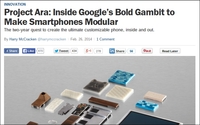Commentary
Who Says Native Can't Go Programmatic (Or Is It That Programmatic Can't Go Native)?
- by Joe Mandese @mp_joemandese, February 28, 2014

Maybe it’s just me -- or maybe it’s just my inbox -- but I was struck by sequential news announcements over the past 24 hours or so that 1) Time Inc. entered into an agreement with
Google to handle its programmatic ad sales, 2) The publication of a major feature by Time magazine tech columnist Harry McCracken calling Google’s “Project Ara” a
“bold gambit,” and 3) Time Inc.’s announcement that it has named M. Scott Havens head of its digital operations.
Don’t get me wrong -- I’m not saying there is any explicit connection between the three developments, but I think they are nonetheless interesting to point out, because there’s an old, tongue-in-cheek rule of thumb in journalism: One is a phenomenon, two is a coincidence, and three is a trend.
Yes, I’d be hard-pressed to draw a direct connection between the timing of Time Inc.’s Google announcement and the fact that it was also promoting Google’s Project Ara -- a DARPA-inspired initiative to build the ultimate smartphone -- under Time magazine’s “innovation” label. And it is a fascinating read (check it out here). But when I saw the Havens announcement, I couldn’t resist drawing some kind of connection, because, well, Havens was president of The Atlantic, which has become something of a poster child for what-not-to-do in native advertising formats. In fact, he was presiding over the venerable magazine -- and its digital operations -- when it published, then immediately pulled and apologized for, the Church Of Scientology’s paid native feature story.
Then again, having gone through that experience, Havens may be the best possible executive to lead Time Inc.’s future native initiatives. If nothing else, he has learned better than anyone else what not to do.
“Why did it happen,” Havens wrote in a subsequent memo to The Atlantic staff. “Quite simply, we did not have clearly established digital advertising guidelines and policies in place, and when you’re innovating in a new territory without standardized guidelines (we’re not alone in the industry on this issue, by the way), mistakes can happen.”
Whatever actually happened, Time Inc., at least, is pretty confident about Havens’ potential. In a memo to Time Inc.’s staff, Executive Vice President
Todd Larsen described Havens as “the ideal executive” to lead the magazine giant’s digital operations, while simultaneously acknowledging its programmatic sales partnership with
Google, but leaving out any mention of McCracken’s Project Ara story.
Meanwhile, I for one will be keeping an eye on the connection between Google and Time Inc.




There may be numerous vendors Time Inc. could have chosen to guide the technology parts of their premium programmatic initiative, but the selection of Google is understandable. Their DoubleClick platform is a known entity in the industry, so they are a safe choice. Over the years, Time has frequently chosen tech industry leaders as preferred vendors. This practice goes back decades; in the late 1900s, the corporation was one of the top ten customers for IBM hardware (mainframe and the early pcs) and services by amount spent. They also were large customer for Atex, Quark and later Adobe when each was a leader in its space.
Henry, Thank you for that perspective. That makes sense.